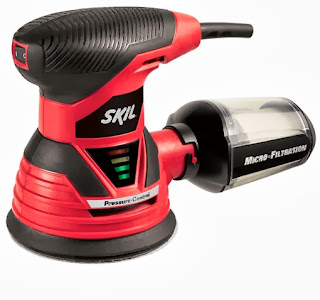Its cousin the belt sander is fitted with a loop of gritty paper that can grind big gouges in wood if held in place too long, like a car tire that's spinning in the mud. Orbit sanders maneuver with greater delicacy and are more forgiving. Fitted with small pads of sandpaper, they buff the surface of wood rather than strafe it. And by moving through a succession of grits, beginning with coarse and moving on up to superfine, it's possible to produce a wood surface as smooth as glass.
Orbit sanders come in two distinct varieties:
- Sheet sander
- Random orbit sander
Sheet Sanders
The sheet sander, which has been on the market for 50 years, is fitted with square or rectangular pieces of sandpaper that are cut to size then clamped into place. When turned on, the pad moves in a small circular pattern. When in use, the tool has to be pushed along with the grain of the wood to minimize surface scratches exactly as is done with hand sanding. Try pushing it against the grain, and the sander will leave a trail of tiny spirals that require even more sanding to remove.The tools come in an assortment of sizes, most of them based on the size of the piece of sandpaper that they use:
- Large sanders can be fitted with a half-sheet of standard sandpaper.
- Smaller models can take quarter-sheets and even sixth-sheets.
- Electronic speed control
- Dust extraction
- Noise and vibration reduction
- Different styles of grips
Random Orbit Sanders
A more recent development is the random-orbit sander. Like the sheet sander, it moves in a small circular motion. But in addition, an offset drive bearing causes the round sanding pad to move in an elliptical orbit as well. The combination of movements produces a random motion to the sanding pad (hence its name), which reduces the possibility for scratching against the grain. This means that the sander can literally be operated in any direction on the wood with the grain, diagonally to the grain, and even against the grain without scratching. Random orbit sanders are not foolproof, however, and the only way to ensure a scratch-free result on a project is to begin with a coarse grit and use successively finer grits until finished.These sanders come in a variety of styles, most relating to the positioning of the grip:
- Palm-grip models: These are the easiest to hold and control, since the sander literally fits into the hand and can be maneuvered easily against narrow surfaces such as window frames.
- Right-angle models: They're more powerful because they have gears that link the motor to the sanding pad. Although the orbit speed is reduced, it's possible to press down on these without causing the motor to labor, making them good tools for stripping glue or paint from a wooden surface.
- Large in-line sanders: These require two hands to operate and have the strongest motors as well as variable-speed controls.
Dealing with Dust
Random-orbit sanders create a lot of sawdust. Yet unlike sheet sanders, these sanders suck up the dust through tiny holes in the sandpaper. The dust can either be collected in a canister that attaches to the machine or even better can be swept into a shop vacuum attachment.Because of this feature, random-orbit sanders require special papers of different diameters and styles that vary from model to model. Most models have sandpaper disks that attach by a Velcro-type hook-and-loop arrangement. But the discs vary according to the number of holes (ranging from five to eight) through which the sawdust is sucked up. To work efficiently, the holes in the sandpaper must line up exactly with the holes in the pad.
